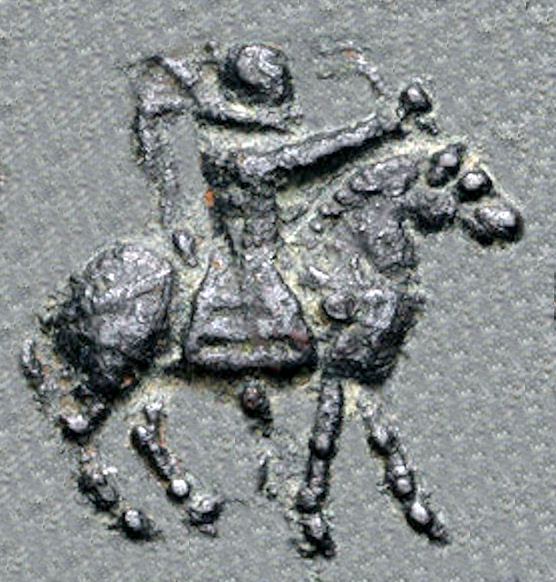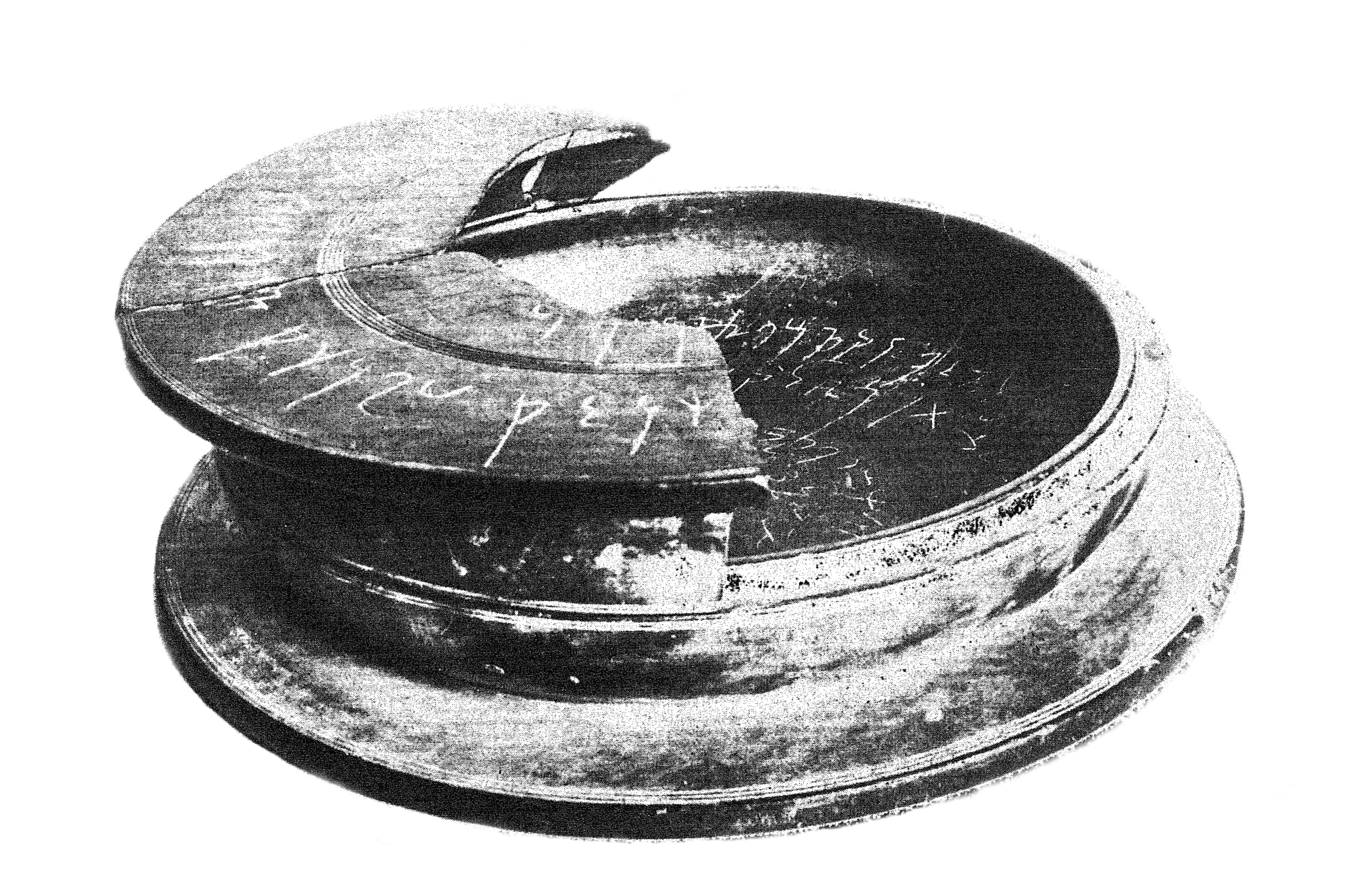|
Vijayamitra
Vijayamitra was an Apracharajas, Apracharaja who ruled in Gandhara, with his capital in Bajaur. He succeeded the previous Apracharaja, Visnuvarma, in 3 BCE with a reign lasting til 32 CE. Rukhana reliquary Vijayamitra is mentioned in a recently discovered inscription in Kharoshthi on a Buddhist reliquary (the "Rukhana reliquary", published by Salomon in 2005), which gives a relationship between several eras of the period, and especially gives confirmation of a Yavana era in relation to the Azes era: :"In the twenty-seventh - 27 - year in the reign of Lord Vijayamitra, the King of the Apraca; in the seventy-third - 73 - year which is called "of Azes", in the two hundred and first - 201 - year of the Yonas (Greeks), on the eighth day of the month of Sravana; on this day was established [this] stupa by Rukhana, the wife of the King of Apraca, [and] by Vijayamitra, the king of Apraca, [and] by Indravarma (Indravasu?), the commander (stratega), [together] with their wives and sons." ... [...More Info...] [...Related Items...] OR: [Wikipedia] [Google] [Baidu] |
Apracha
The Apracharajas (Gandhari Prakrit, Gandhari: 𐨀𐨤𐨿𐨪𐨕𐨪𐨗), also known as Avacarajas (Gandhari Prakrit, Gandhari: 𐨀𐨬𐨕𐨪𐨗),Richard G. Salomon (professor of Asian studies), Richard Salomon, ''An Inscribed Silver Buddhist Reliquary of the Time of King Kharaosta and Prince Indravarman'', Journal of the American Oriental Society, Vol. 116, No. 3 (Jul. - Sep., 1996), pp. 418–452 were a local ruling dynasty of Gandhara. The ''Apracharaja'' capital, known as Apracapura (also Avacapura), was located in Bajaur District, Bajaur, though from numismatic evidence and reliquary inscriptions, it is asserted that their territory encompassed the wider region of Gandhara, including the cities of Taxila and Pushkalavati. Under the administration of Sases, their domain expanded to incorporate the former territory of the kingdom of Porus, which extended as far as the river Ravi in the Punjab. Based on analysis of their inscriptions and coinage, the Apracharajas are wide ... [...More Info...] [...Related Items...] OR: [Wikipedia] [Google] [Baidu] |
Apracharajas
The Apracharajas ( Gandhari: 𐨀𐨤𐨿𐨪𐨕𐨪𐨗), also known as Avacarajas ( Gandhari: 𐨀𐨬𐨕𐨪𐨗), Richard Salomon, ''An Inscribed Silver Buddhist Reliquary of the Time of King Kharaosta and Prince Indravarman'', Journal of the American Oriental Society, Vol. 116, No. 3 (Jul. - Sep., 1996), pp. 418–452 were a local ruling dynasty of Gandhara. The ''Apracharaja'' capital, known as Apracapura (also Avacapura), was located in Bajaur, though from numismatic evidence and reliquary inscriptions, it is asserted that their territory encompassed the wider region of Gandhara, including the cities of Taxila and Pushkalavati. Under the administration of Sases, their domain expanded to incorporate the former territory of the kingdom of Porus, which extended as far as the river Ravi in the Punjab. Based on analysis of their inscriptions and coinage, the Apracharajas are widely believed to have served as significant benefactors of Buddhism. Translated inscriptions indi ... [...More Info...] [...Related Items...] OR: [Wikipedia] [Google] [Baidu] |
Vijayamitra King On Horse
Vijayamitra was an Apracharaja who ruled in Gandhara, with his capital in Bajaur. He succeeded the previous Apracharaja, Visnuvarma, in 3 BCE with a reign lasting til 32 CE. Rukhana reliquary Vijayamitra is mentioned in a recently discovered inscription in Kharoshthi on a Buddhist reliquary (the " Rukhana reliquary", published by Salomon in 2005), which gives a relationship between several eras of the period, and especially gives confirmation of a Yavana era in relation to the Azes era: :"In the twenty-seventh - 27 - year in the reign of Lord Vijayamitra, the King of the Apraca; in the seventy-third - 73 - year which is called "of Azes", in the two hundred and first - 201 - year of the Yonas (Greeks), on the eighth day of the month of Sravana; on this day was established hisstupa by Rukhana, the wife of the King of Apraca, ndby Vijayamitra, the king of Apraca, ndby Indravarma ( Indravasu?), the commander (stratega), ogetherwith their wives and sons." This dedication i ... [...More Info...] [...Related Items...] OR: [Wikipedia] [Google] [Baidu] |
Gandhara
Gandhara () was an ancient Indo-Aryan people, Indo-Aryan civilization in present-day northwest Pakistan and northeast Afghanistan. The core of the region of Gandhara was the Peshawar valley, Peshawar (Pushkalawati) and Swat valleys extending as far east as the Pothohar Plateau in Punjab, though the cultural influence of Greater Gandhara extended westwards into the Kabul, Kabul valley in Afghanistan, and northwards up to the Karakoram range. The region was a central location for the Silk Road transmission of Buddhism, spread of Buddhism to Central Asia and East Asia with many Chinese Buddhism, Buddhist pilgrims visiting the region. Between the third century BCE and third century CE, Gandhari language, Gāndhārī, a Middle Indo-Aryan languages, Indo-Aryan language written in the Kharosthi script and linked with the modern Dardic languages, Dardic language family, acted as the lingua franca of the region and through Buddhism, the language spread as far as China based on Gandhār ... [...More Info...] [...Related Items...] OR: [Wikipedia] [Google] [Baidu] |
Rukhana Reliquary
The Rukhuna reliquary, also sometimes Rukhana reliquary, also described as the Bajaur reliquary inscription, is a Scythian reliquary which was dedicated and inscribed in 16 CE by Rukhuna, Queen of Indo-Scythian king Vijayamitra (ruled 12 BCE - 20 CE). The inscription on the reliquary, also called the Bajaur reliquary inscription, was published by Richard Salomon with a photograph in 2005, and gives a relationship between several eras of the period, and especially a confirmation of a Yavana era (''Yoṇaṇa vaṣaye'') in relation to the Azes era, that is "Azes era= Yavana era - 128 years". Inscription The inscription is very useful to clarify relative chronologies during the period. The inscription reads: In Kharoshthi, the referential dates at the beginning of the inscription appear both in words and in numbers, together with the name of the era they are calculated in, and are given as follows: This dedication also indicates that King Vijayamitra and his wife Rukhuna w ... [...More Info...] [...Related Items...] OR: [Wikipedia] [Google] [Baidu] |
Indravasu
Indravasu (Kharosthi: 𐨀𐨁𐨎𐨡𐨿𐨪𐨬𐨯𐨂 Richard Salomon, ''An Inscribed Silver Buddhist Reliquary of the Time of King Kharaosta and Prince Indravarman'', Journal of the American Oriental Society, Vol. 116, No. 3 (Jul. - Sep., 1996), pp. 418-452) was an Apracharaja ruling in Gandhara with his capital in Bajaur of modern Pakistan. He succeeded the previous Apracharaja, Vijayamitra in 32 CE. Rukhana reliquary He is mentioned in a recently discovered inscription in Kharoshthi on a Buddhist reliquary (the "Rukhana reliquary", published by Salomon in 2005), which gives a relationship between several eras of the period, and especially gives confirmation of a Yavana era in relation to the Azes era. He was the son of king Vijayamitra. Silver Buddhist reliquary of Prince Indravarma He is also mentioned as king of the Apraca The Apracharajas ( Gandhari: 𐨀𐨤𐨿𐨪𐨕𐨪𐨗), also known as Avacarajas ( Gandhari: 𐨀𐨬𐨕𐨪𐨗), Richard Salomon, ... [...More Info...] [...Related Items...] OR: [Wikipedia] [Google] [Baidu] |
Shinkot Casket
The Shinkot casket, also Bajaur reliquary of the reign of Menander, is a Buddhism, Buddhist reliquary from the Bajaur District, Bajaur area in Gandhara, thought to mention the reign of the 2nd century BCE Indo-Greek king Menander I. The steatite casket is said to have contained a silver and a gold reliquary at the time of discovery, but they have been lost. Inscription This casket is probably the oldest known inscribed Buddhist relic casket from the area of Gandhara. One of its inscriptions, in the place of honour on the lid, mentions: ''Minedrasa maharajasa kaṭiasa divasa 44411'', being translated as "On the 14th day of Kārtikka, in the reign of the Maharaja Minadra", the ''Maharaja'' ("Great King") ''Minadra'' in question being Menander I, Menander. Menander is otherwise known from his coins, which are generally bilingual in Greek and Kharoshthi, where his Kharoshthi name is given as ''Menadra''. On his coinage, the full title of king Menander appears as ''Menadrasa Maharaja ... [...More Info...] [...Related Items...] OR: [Wikipedia] [Google] [Baidu] |
Yavana Era
The Yavana Era, or Yona (Prakrit: ''Yoṇaṇa vaṣaye'') was a computational era used in the Indian subcontinent from the 2nd century BCE for several centuries thereafter, probably starting in 174 BCE.Des Indo-Grecs aux Sassanides: données pour l'histoire et la géographie historique, Rika Gyselen, Peeters Publishers, 2007, p.103-10/ref> It was initially thought that the era started around 180-170 BCE, and corresponded to accession to the Greco-Bactrian throne of Eucratides, who solidified Hellenic presence in the Northern regions of India. The Greeks in India flourished under the reign of the illustrious, Menander - greatest of the Yavana rulers, who campaigned as far as Pataliputra in Eastern India. It is now equated with the formerly theorized "Old Śaka era". Harry Falk and others have suggested that the Yavana era actually started in 174 BCE, based on a reevaluation of the Azes era which is now thought to have started in 47/46 BCE. The exact historical event corresponding ... [...More Info...] [...Related Items...] OR: [Wikipedia] [Google] [Baidu] |
Azes Era
The "Azes era" (also known as the ''Aja'' or ''Ajasa'' era, Prakrit: ''Ayasa vaṣaye'') starting 47/46 BCE, was named after the Indo-Scythian king, "King Azes the Great" or Azes I. As a number of inscriptions are dated in this era it is of great importance in dating the reigns of several kings and events in early Indian history. Earlier, some scholars believed that the Azes era was same as the Vikrama Samvat (57 BCE) used in the Indian subcontinent. However, this was disputed by Robert Bracey following discovery of an inscription of Vijayamitra, which is dated in two eras. Research by Falk and Bennett (2009) shows that these two were indeed separate eras, and that the Azes era can be dated with a high degree of likelihood to 47 BCE, or c. 48/47 or 47/46 BCE, depending on whether it began in the spring or the autumn. It is now thought that the Azes era was probably created by Azes as a continuation of the Arsacid era which started in 247 BCE and marked the foundation of the Pa ... [...More Info...] [...Related Items...] OR: [Wikipedia] [Google] [Baidu] |






